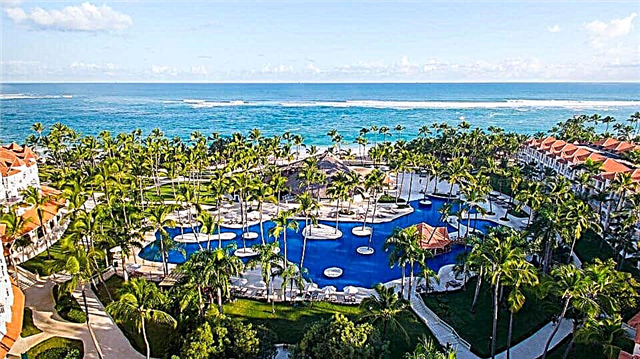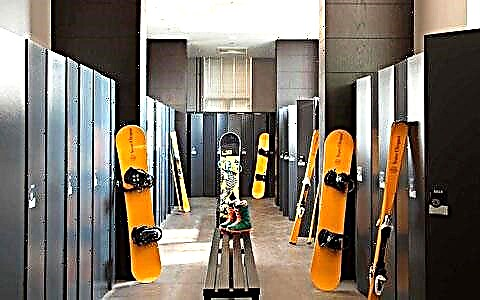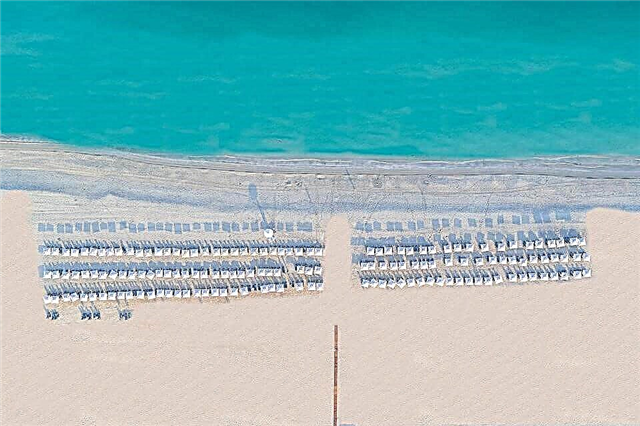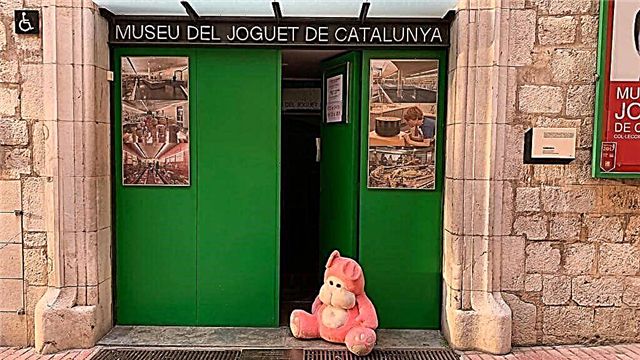Everything is interesting for travelers in the "" immortal city "of Girona. The old streets of the Jewish quarter, the embankment of the Onyar River, majestic cathedrals, temples, various medieval buildings, the old fortress wall (Gerunda), built during the Roman Empire. Learn the ancient history of the city, Spain is offered not only during walking, but also by visiting the numerous museums of Girona.
Girona Art Museum

Walking through the old quarter of the city, one cannot fail to notice the architectural masterpiece of the 10th century, the Episcopal Palace (Palacio Episcopal). Now before us is a restored Renaissance building of the Renaissance style of the 17th century. It is not surprising that it houses interesting exhibitions of works of art reflecting the history of the country.
The institution appeared in 1976 on the basis of the merger of several organizations: the Diocesan, the Provincial Museum of Antiques, the Fine Arts Institution. The purpose of the creation was the desire and need to preserve, explore the cultural heritage of Girona, starting from the colonial period. Roman, Gothic collections are the third most important heritage sites in Catalonia. The archives contain 8.5 thousand historical elements.
The exposition of the chronological exhibition is located in 18 rooms. Among them it is proposed to see a portable altar, a pectoral cross, the myrrh-bearer of Sant Pere de Rodes. Jewelry, antique dishes decorated with blue shades, stained-glass windows, glassware of the 16th-19th centuries, rare liturgical art objects, embroidery of the 15th century, paintings by famous artists. Of interest is the only copy of an old typewriter (XI century), St. Catherine's pharmacy, located on the ground floor.
Film Museum

The technical capabilities of modern cinema well reflect the level of progress in optics, electronics, sound recording, etc. The world path of its development is associated with the emergence of interesting devices, inventions, discoveries. Thanks to the creation of special glasses, new software for calculating complex optical systems, modern cinema lenses have appeared. The collection of such items has been created for 30 years by Thomas Mallol. It became the basis for the creation of the first Film Museum in Spain.
He started working in 1998. During this time, more than 20 thousand exhibits have been collected. There are 8000 unique cine lenses alone, 98 types of cameras, many devices for making children's films. The library contains books, magazines on the art of cinema. The archives of the museum contain 10,000 documents, posters, a video library. The Institute for Film Research operates on the basis of the organization. Permanent and offsite exhibitions are held.
Address: Carrer de la Sèquia, 1, 1700.
Museum of Jewish History

The history of Spain is connected with the life of the ancient Jewish community, which came to Girona in the 9th century from the town of Castello de Empuries. They created the Jewish Quarter, an atmosphere of life that has survived to this day. Despite persecution, persecution, she froze forever in the narrow cobbled streets of Kundaro and Carrer Escola Pia, St. Lawrence.
Here, in the stone walls, special windows are still visible, where precious parchments (mezuzahs) with Torah verses were fastened. Holding on to them, the inhabitants of the houses prayed. They are invited to see them in the unusual Museum of Jewish History. It is located in the old synagogue and occupies 11 rooms. Each presents an exposition of objects corresponding to a specific side of the life of the Jewish people during their life in Catalonia from the 20th to the 15th century.
Collected numerous documents describing the reasons why Girona is called "the cradle of Israel." How and when the school of the Cabalists was born in the city (for the first time on the Iberian Peninsula). The institution operates the Institute of Judaism. Ben Nachman (philosopher and cabalist). During the excursions, it is proposed to inspect the entire building, to see the ancient Jewish premises that keep the medieval secrets of the community.
Archeology Museum of Catalonia

The culture of Catalonia combines the traditions of different peoples who have inhabited it since ancient times (Romans, Goths, Jews, Franks, etc.). Ancient cities, architectural monuments and many items found during archaeological excavations are proof of their life.
The most amazing discoveries took place in 1846 at the site of the excavation of the Roman city of Herunda and the old Jewish cemetery. Scientists have confirmed that a rare sarcophagus with ancient epitaphs and unique mosaics were made in the 4th century. In order to preserve priceless finds in 1857 in Girona (one of the oldest cities in Catalonia, known as Gerona, Herunda, Gerona, Gerunda) in 1957 the Archaeological Museum began to work, which became the oldest museum in Catalonia.
It houses a huge collection of artifacts found in and around the ancient city. In terms of subject matter, they cover the time from the first settlement to the Middle Ages. Exhibition expositions, archives are located in the monastery of Sant Pere de Galngans.
The address of the institution is Carrer de Santa Llúcia, 8, 17007.
Museum of the History of Girona

The rich expositions present all the stages of the formation and development of Girona, which appeared in the 1st century. The walls of the restored fortress can tell about the battles, the life of the Romans, the French, the Moors. Spaniards, Jews. The oldest European quarter, Ile-Kall (Jewish), has still preserved the atmosphere of life of people who had a strong influence on the culture and traditions of Girona. The elements of the expositions are grouped by subject, time and are located in 14 exhibition halls.
The history of the first city of Herunda, the way of life of its population, the development of life in the vicinity are reflected in the collections of preserved artifacts and documents. Thematic proposals of the exhibitions tell about the methods of democratic governance in Girona, the development of technology, the history of the creation of the dance "sardana".
It is proposed to see a unique collection of musical instruments, hear about the life of a modern city or about the ancient street Carrer Forca, paved by the Romans. About the Cathedral of the Holy Virgin Mary, the famous symbol of the "immortal city" - the Lioness of Girona. The building is located near the Cathedral.
Confiture Museum

Jam, jam, marmalade, sauces, delicious confitures are considered a delicacy among all nations. They are prepared from various fruits, vegetables, nuts according to traditional recipes. It is pleasant to drink tea with them, to taste a delicious pie with a non-flowing filling, tasty, neat. It is made from a product called confiture. A special kind of jam was known from the writings of Pliny the Elder, written in 77 BC. It looked like honey jam.
It is believed that the modern type of jam appeared in Hungary in the 17th century. The French were the first to use gelatin in the technology of making dessert. For a detailed history of the creation of a sweet dish, please visit the Jam Museum. You are allowed to try the delicacy, take part in its creation, master the recipes for rare confitures. In the building, restaurants of the city, specialized stores, different types of confiture are sold, including the famous onion.
Address: Plaça Major, s / n, 17123 Torrent (Girona).
Rafael Maso House Museum

Together with the ancient architectural monuments of the city, buildings of the 19th and 20th centuries are of interest. Among the famous masters of Spain of this time was the name of the architect Rafael Maso. Its style is based on the elements of Novosentism, combined with the requirements of modern Catalan architecture.
The master was the creator of private villas, wealthy houses, government institutions (factories, schools, shops). The Athenea Cultural Center was built according to his ideas. The most significant work is the home of the Rafael Maso family.It is a beautiful complex of four five-storey buildings, united by an original façade overlooking the Oniar River. It houses the Raphael Maso Museum.
The interior of the building has been fully preserved and effectively tells the story of the life of the owner. Here you can see a library, a living room, a room for embroidery, a gallery with paintings by famous artists (for example, works by Eugenio Lucas, Velazquez, Goya, Vincent Lopez, Modest Urgel). The mansion is now owned by the city council. In order to preserve the cultural heritage of the master, a special fund named after him was created in 2006. He participates in the life of the city, cultural events.
Address: Casa Masó, 29 Ballesteries, 17004.
Theater-Museum of Salvador Dali

You can see the works of the genius artist, touch the secrets of his life in the halls of three institutions: the Gala Dali castle in Pubol, the Salvador Dali house-museum in Portligat, the Dalí Theater-Museum in Figueres, The destroyed theater building became the most popular museum in Spain thanks to Dalí's efforts.
According to the artist's idea, a giant dome was built, the area of the hall was divided into three parts for exhibitions of works of various genres. The foyer is decorated with the work of Dali, where he and Gala wash gold in Figueres. In the crypt under the dome is a slab of white marble.
This is a tombstone over the artist's embalmed body. The will was the desire to bury him so that people could pass in this place. The organization began to function in 1961, but the official opening took place in September 1974.
The exhibitions contain paintings, sculptures, installations by Dali. There is even experimental work on halography. The jewelry exposition presents 39 works made by the master from gold and precious stones. There are also designer sketches and drawings.
Toy Museum of Catalonia

The world of children's toys is a real planet with its own laws of development, achievements and discoveries. Modern technologies in the field of obtaining new materials, computer capabilities have changed, supplemented it. But always next to the "cartoon" hero in our children you can see a soft hare, a teddy bear, etc.
And then a legitimate question arises: "What toys did our great-grandmothers play with?" It is good if a large and fat bear, filled with sawdust, has survived among the numerous kingdom of toys. But if it is not there, then it is worth visiting the interesting toy museum, located in the old house of Baron Terrades.
He started working in December 1998. Toys from a private collection became the basis. Today the number of exhibits has reached 4,000 items. Among them are mechanical toys, cardboard, metal, animal figures.
Special devices for the visually impaired, small copies of real cars, dolls, etc. Exhibitions of toys belonging to famous people (Dali, Lorca) are organized. It is suggested to see the railway made in 1937. The collection of old photographs complements the chronological order of birth of the toys. In front of the entrance there is a figure of a cow, and the famous classics, played by our ancestors, are painted on the path. The symbol of the museum is the figure of a cat. Maybe because her gentle purr is heard even in the toy version.











